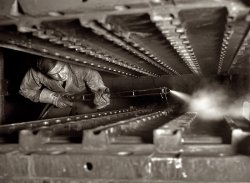
MAY CONTAIN NUTS

Search Shorpy
SHORPY ART

Framed or unframed, desk size to sofa size, printed by us in Arizona and Alabama since 2007. Explore now.
Join and Share
Ad-Free Shorpy
Shorpy is funded by you. Patreon contributors get an ad-free experience.
Learn more.

Recent comments
- Baldwin 62303
- Baldwin VO-1000
- Cold
- No expense spared
- Tough Guys
- Lost in Toyland
- And without gloves
- If I were a blindfolded time traveler
- Smoke Consumer Also Cooks
- Oh that stove!
- Possibly still there?
- What?!?
- $100 Reward
- Freeze Frame
- Texas Flyer wanted
- Just a Year Too Soon
- WWII -- Replacing men with women at the railroad crossing.
- Yes, Icing
- You kids drive me nuts!
- NOT An Easy Job
- I wonder
- Just add window boxes
- Icing Platform?
- Indiana Harbor Belt abides
- Freezing haze
- Corrections (for those who care)
- C&NW at Nelson
- Fallen Flags
- A dangerous job made worse
- Water Stop
Member Photos
The Shorpy
Print Emporium
Print Emporium
Search Shorpy
Search results -- 30 results per page
- In a Flattering Light: 1942
- ... 1942. View full size. 4x5 Kodachrome transparency by Alfred Palmer for the Office of War Information.
Lee Tank An M3 "Lee" Medium ... Posted by Dave - 08/05/2012 - 6:32pm -
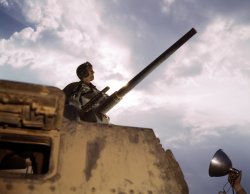
- Primary Colors: 1942
- ... View full size. 4x5 Kodachrome transparency by Alfred Palmer for the Office of War Information.
(The Gallery, Kodachromes, Alfred ... Posted by Dave - 08/30/2012 - 2:03pm -
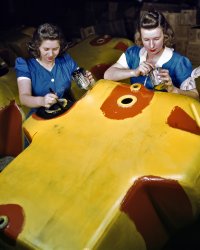
- Wingman: 1942
- ... plane in existence." 4x5 Kodachrome transparency by Alfred Palmer, Office of War Information. View full size.
The Union ... Posted by Dave - 08/05/2012 - 6:38pm -
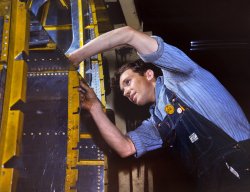
- TVA: 1942
- ... Dam. View full size. 4x5 Kodachrome transparency by Alfred Palmer, Office of War Information.
(The Gallery, Kodachromes, Alfred ... Posted by Dave - 08/08/2012 - 8:18pm -
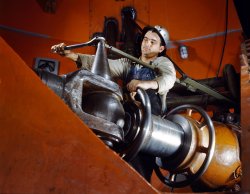
- Learning to Fly: 1942
- ... Field." View full size. 35mm Kodachrome transparency: Alfred Palmer.
Yelling the Word CONTACT!
(The Gallery, Alfred Palmer, ... Posted by Dave - 06/11/2008 - 9:31pm -
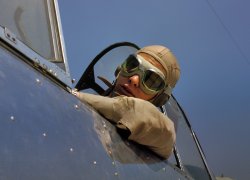
- Republic Steel: 1941
- ... View full size. 4x5 Kodachrome transparency by Alfred Palmer.
(The Gallery, Kodachromes, Alfred Palmer, Industry & Public Works) ... Posted by Dave - 08/10/2012 - 3:46pm -
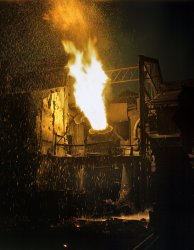
- Pajama Squadron: 1942
- ... Corps glider detachment training camp." From photos by Alfred Palmer and Pat Terry for the Office of War Information. View full size.
... Posted by Dave - 09/27/2017 - 8:41pm -
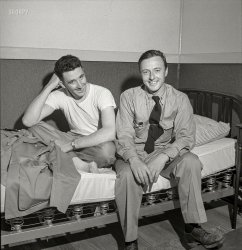
- Big Bird With All the Trimmings: 1942
- ... Wright Whirlwind engines." 4x5 Kodachrome transparency by Alfred Palmer. View full size.
(The Gallery, Kodachromes, Alfred Palmer, ... Posted by Dave - 08/30/2012 - 1:59pm -
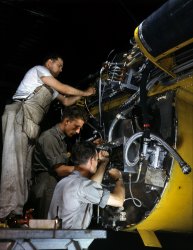
- New River: 1942
- ... View full size. 4x5 Kodachrome transparency by Alfred Palmer, Office of War Information.
Dog tags Is it possible to blow up ... Posted by Dave - 07/24/2012 - 9:37pm -
![New River: 1942 May 1942. Marine transport driver at New River, North Carolina. View full size. 4x5 Kodachrome transparency by Alfred Palmer, Office of War Information.
Dog tagsIs it possible to blow up the dog tags on the Marine on the left enough to get a name or serial number off of them?
[Not much to see. - Dave]
(The Gallery, Kodachromes, Alfred Palmer, Cars, Trucks, Buses, WW2)](https://www.shorpy.com/files/images/1a35185u.thumbnail.jpg)
- Victory Corps: 1942
- ... the school's basement." Large format acetate negative by Alfred Palmer for the Office of War Information. View full size.
Re: Very ... Posted by Dave - 02/25/2013 - 2:09pm -
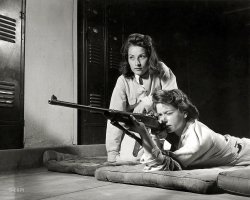
- North American Aviation: 1942
- ... View full size. 4x5 Kodachrome transparency by Alfred Palmer.
(The Gallery, Kodachromes, Alfred Palmer, Aviation, WW2) ... Posted by Dave - 08/30/2012 - 12:03pm -
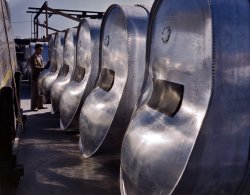
- Just Getting Warmed Up: 1941
- ... View full size. 4x5 Kodachrome transparency by Alfred Palmer for the Office of War Information.
(The Gallery, Kodachromes, Alfred ... Posted by Dave - 08/30/2012 - 4:42pm -
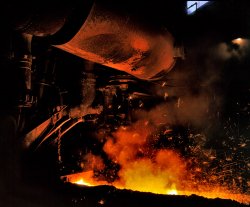
- Etna: 1941
- ... View full size. 4x5 Kodachrome transparency by Alfred Palmer for the Office of War Information.
Elizabeth Furnaces This sure ... Posted by Dave - 08/01/2012 - 1:33pm -
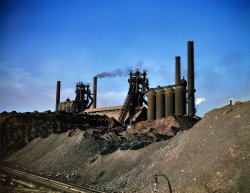
- The Avengers: 1943
- ... the Axis, one rivet at a time. Kodachrome transparency by Alfred Palmer, Office of War Information. View full size.
Airless Pneumatics ... Posted by Dave - 01/09/2013 - 10:03pm -
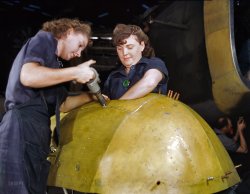
- On the Ground: 1942
- ... training camp at Parris Island, South Carolina." Photo by Alfred Palmer for the Office of War Information. View full size.
Photographer ... Posted by Dave - 04/19/2013 - 5:16pm -
![On the Ground: 1942 May 1942. "Running up a barrage balloon. Scene at the U.S. Marine Corps glider detachment training camp at Parris Island, South Carolina." Photo by Alfred Palmer for the Office of War Information. View full size.
Photographer at 12 O'Clock HighLooks like the photographer was up in the lines and caught his own shadow in the picture. It appears to have been taken around noon.
MysteriousTill I saw Perpster's comment I assumed the shadow at left center was a partially inflated balloon, and the upturned sacks surrounding the Marine handler were the ballast sandbags like you would use with a manned balloon. However, that shadow is definitely human-shaped on closer view, and that just makes the entire operation hard to understand.
If the sacks are deflated balloons, where are the manifold and hoses for inflating them? The handler has his arms outstretched like he's signaling someone we can't see or about to pick up one of the sacks. This one could use comments from someone who has actually deployed barrage balloons -- I know what they look like when they are airborne, but they were way before my time.
[The balloons were bigger than a breadbox. - Dave]
(The Gallery, Alfred Palmer, WW2)](https://www.shorpy.com/files/images/SHORPY_8d20571u.thumbnail.jpg)
- Stacked: 1942
- ... to the Army. View full size. 5x7 nitrate negative by Alfred Palmer.
Akron Must've been cold that day.
(The Gallery, Alfred ... Posted by Dave - 09/05/2012 - 2:59pm -
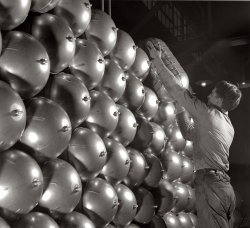
- Making Tracks: 1941
- ... section." View full size. 4x5 nitrate negative by Alfred Palmer.
Stelllaaaaa! The real-life Stanley Kowalski, at last i've found ... Posted by Dave - 04/24/2008 - 1:17am -
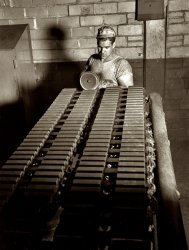
- Now It Can Be Told: 1942
- ... Speed Victory! View full size. 4x5 nitrate negative by Alfred Palmer for the Office of War Information.
Is that a technical term? ... Posted by Dave - 07/01/2008 - 2:28am -
![Now It Can Be Told: 1942 February 1942. Akron, Ohio. Another esoteric industrial process involving scary-looking thingamabobs essential to the war effort. Executive summary: Performing a painstakingly choreographed ballet of complicated tasks at precisely timed intervals, Joe Warworker here is doing his part to Speed Victory! View full size. 4x5 nitrate negative by Alfred Palmer for the Office of War Information.
Is that a technical term?"Scary looking thingamabobs"? LOL! Now I've just got to know what they really are. Fuel cylinders perhaps?
[Aviation oxygen tanks. - Dave]
In The Movie Adaptation......He would be played by William Bendix.
Coded ChemicalsWhen I went to work at the Oak Ridge Gaseous Diffusion Plant in Tennessee in the mid-sixties, some of the old timers were still referring to common compressed gases by their wartime code names. We still had a section in the plant called "Coded Chemicals."
Atomic WeldingI'd guess "atomic [sic.] welding machine" should be "automatic welding machine" in this caption.
[Atomic welding is correct. Short for atomic hydrogen welding. - Dave]
Hydrostatic Testing of Oxygen BottlesThis looks like the setup to pressure test the oxygen bottles using water rather than a gas. Using a gas would create a bomb like effect if there was a defect present and the tank ruptured. Using water under pressure will do the same job but will not have the compressed and stored energy that a gas would have. You get a bang, a big crack and a spurt of water rather than a big bang that destroys the facilty and anyone in the way!!!
Still a practice used today for testing pressurized gas containers like Scuba tanks, oxygen bottles , propane cylinders etc.
These look like the "low" pressure bottles that were used for military aircraft - around 300 psi charge rather than the 1800 psi "high" pressure ones used today on aircraft. The reasoning was simple - a bullet or failure of a 300 psi bottle would cause much less damage than the same hit to a high pressure one. The ones I have seen were all painted a bright yellow - and I still have one somewhere in my parents stored junk out at the farm where we used it for a compressed air tank conected to a small air compressor.
(The Gallery, Alfred Palmer, WW2)](https://www.shorpy.com/files/images/8e10965u.thumbnail.jpg)
- Watts Bar Dam: 1942
- ... View full size. 4x5 Kodachrome transparency by Alfred Palmer.
scale model workers hmm.. these look just like scale model ... Posted by Dave - 08/05/2012 - 6:35pm -
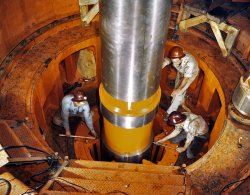
- The Wood Bomber: 1942
- ... More here and here . Kodachrome transparency by Alfred Palmer for the Office of War Information. View full size .
"Hint: ... Posted by Dave - 05/28/2018 - 2:15pm -
![The Wood Bomber: 1942 October 1942. "Preparing a model of the B-25 bomber for the wind tunnel at North American Aviation's plant at Inglewood, Calif." More here and here. Kodachrome transparency by Alfred Palmer for the Office of War Information. View full size.
"Hint: Safety"I too am in the "Protect the floor from scratches" camp mentioned in the comment by "Born40YearsTooLate" .
Dave, could you please elaborate on your "Hint: Safety" addendum.
[Shoes, hats and other potential projectiles are banned in wind tunnels lest they come off if the fan comes on. - Dave]
Nice Memorial Day reference. Two comments/thoughts:
1) I grew up in the panhandle of Florida next to Eglin Air Force base as the son of a USAF civilian defense worker in weaponry. There are no less than six abandoned airfields in the general area which were used as satellite strips dating back to pre-WWII.
One of them was used to train Doolittle's raiders in getting the Mitchell off the ground in 300' as training for their upcoming USS Hornet launch (which was only known to Doolittle at the time until they were under sea and ready to launch). The last I checked about 20 years ago, the white stripe marking 300' was still there on the old runway they used. I do not see it on Googlemap's satellite overhead now though.
2) There is a scratch built giant 1/3 scale (!) B-25 R/C model out there. It is incredible to watch. This looks to be about a 1/5 scale. Here's said 1/3 scale and you can tell the enormous size difference with this model based on the guy in the back and the twin tail separation distance with his shoulders for reference:
https://www.youtube.com/watch?v=0QBASNFgCTo
No shoes allowedI notice that the technician is in stocking feet, so I'm assuming that's to protect the floor of the tunnel from scratches that could throw off calibration or introduce drag.
[That's not the reason. (Hint: safety) - Dave]
Could it be possiblethat wooden mock-up model would have been saved to a museum??
(The Gallery, Kodachromes, Alfred Palmer, Aviation, WW2)](https://www.shorpy.com/files/images/SHORPY-1a35317u.thumbnail.jpg)
- Take No Chances: 1941
- ... tough durable piece." View full size. 4x5 negative by Alfred Palmer for the Office of War Information.
Still in use in 1980 I've seen ... Posted by Dave - 04/21/2008 - 10:05pm -
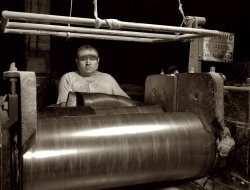
- Army Smartness: 1941
- ... up to Army standards of smartness." 4x5 negative by Alfred Palmer for the Office for Emergency Management. View full size.
... Posted by Dave - 11/06/2014 - 3:50pm -
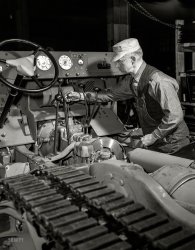
- Untethered: 1942
- ... important locations from enemy aircraft." Photos by Alfred Palmer and Pat Terry for the Office of War Information. View full size.
... Posted by Dave - 05/28/2013 - 8:36am -
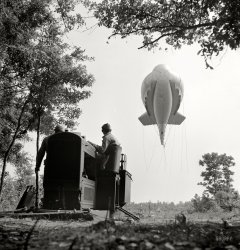
- Heavy Lifting: 1942
- ... Valley Authority." 4x5 Kodachrome transparency by Alfred Palmer for the OWI. View full size.
(The Gallery, Kodachromes, Alfred ... Posted by Dave - 08/30/2012 - 4:44pm -
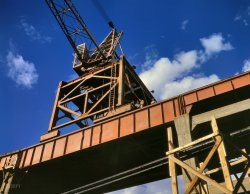
- Etna: 1941
- ... View full size. 4x5 Kodachrome transparency by Alfred Palmer.
Steel mill Such a crisp clear pict it's really great, and the ... Posted by Dave - 08/08/2012 - 8:17pm -
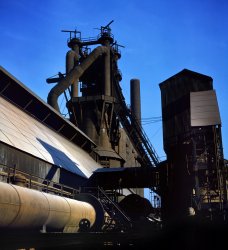
- No Springs: 1942
- ... and Copper Company, Euclid, Ohio." 4x5 nitrate negative by Alfred Palmer for the Office of War Information. View full size.
Cast into ... Posted by Dave - 11/20/2011 - 5:20pm -
![No Springs: 1942 February 1942. "Conversion. Copper and brass processing. Weighing brass scrap. The war program calls for the use of such vast amounts of brass and copper, among other metals, that all available scrap must be utilized. Here a truckload of brass trimmings from a sheet mill is being weighed. From here it will go to the casting shop, where it will be remelted and cast again into billets. Chase Brass and Copper Company, Euclid, Ohio." 4x5 nitrate negative by Alfred Palmer for the Office of War Information. View full size.
Cast into billets?A "billet" is a letter or soldiers' quarters, neither of which are ordinarily made of copper and brass. Is there another definition for "billets?" Or is that a typo for "bullets?"
[A billet is a metal slug. - Dave]
Billet — A semifinished‚ cogged‚ hot-rolled or continuous-cast metal product of uniform section‚ usually rectangular with radiused corners. Billets are relatively larger than bars.
Cool! Thanks for the info. Now I'll have to devise a way to casually work that into the dinner table conversation tonight.
(The Gallery, Alfred Palmer, WW2)](https://www.shorpy.com/files/images/SHORPY_8e10875u.thumbnail.jpg)
- Fledglings: 1942
- ... powered by a Pratt & Whitney Wasp engine." Photo by Alfred Palmer for the Office of War Information. View full size.
Quite a ... Posted by Dave - 07/06/2013 - 10:53am -
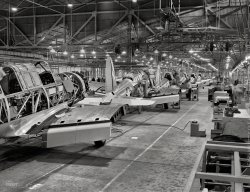
- Fort Knox: 1942
- ... View full size. 4x5 Kodachrome transparency by Alfred Palmer.
(The Gallery, Kodachromes, Alfred Palmer, Patriotic, WW2) ... Posted by Dave - 08/05/2012 - 6:35pm -
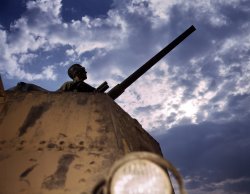
- Fly Me to the Moon: 1942
- ... format nitrate negative from photos by by Pat Terry and Alfred Palmer for the Office of War Information. View full size.
Kinda basic ... Posted by Dave - 08/06/2014 - 12:34pm -
![Fly Me to the Moon: 1942 May 1942. Parris Island, South Carolina. "Marine Corps glider detachment training camp. A glider winch." Medium format nitrate negative from photos by by Pat Terry and Alfred Palmer for the Office of War Information. View full size.
Kinda basicWell,
- Engine - check!
- Drive shaft - check!
- Cable drum - check!
- Power lever - can't see it, but I guess it will be a pedal - check!
- Safety cage - a very strong must for a winch, those cables are like band saws if they get out of control - check!
- Brake - can't see that, either, but I would guess another pedal - check!
- Cable guillotine - can't see that either, but it is an indispensable safety item.
Well, what is that steeringwheelgood for? My first guess would be a manual cable spooling guide. To reduce wear and tear and cable salad potential.
And voila, you got a glider winch.
More modern incarnations can be found galore under http://www.skylaunch.de/album/
Wrong WayUnless it pulls gliders from behind the guy's back, it's facing the wrong way. The gliders would be taking off downwind, making them uncontrollable.
The cage keeps the end of the cable with a little parachute attached from falling on him. The glider releases it pretty much right overhead.
[I suspect they know what they're doing. Below, two more views. - Dave]
TiredThe wheel and hubcap are from a 1937 Ford V8 equipped vehicle, and the hood seems to be from a 1928 Chevrolet.
Gliders in GermanyI had never seen gliders launched this way until I was serving in the Army in Giessen, Germany in 1965-1967. The website in the post by StefanJ, under the "G" tab, will get you to the Giessen glider club's website - they used winches to launch their gliders back then, and apparently still do.
(The Gallery, Alfred Palmer, Aviation, WW2)](https://www.shorpy.com/files/images/SHORPY-8d20782u1.thumbnail.jpg)
- A Tight Spot: 1941
- ... Akron, Ohio." View full size. 4x5 nitrate negative by Alfred Palmer for the Office of War Information.
(The Gallery, Alfred Palmer, WW2) ... Posted by Dave - 05/13/2008 - 3:00pm -
